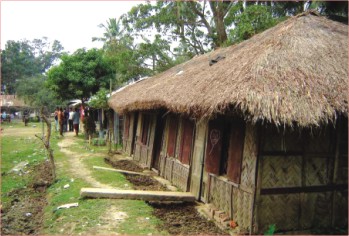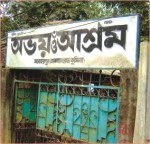Journey through Bangldesh
From Comilla

Zakir Azad

The place where Obhoy Ashram stands today, used to be under KTCC's circle. People still use the old name, Obhoy Ashram. It's in Laksam Road, just to the left of the Ostad Ayat Ali Khan Street, where Gandhiji, Rabindranath Tagore, Simanto Gani Abdul Gaffar Khan and Mohammad Ali Jinnah have left their footprints” said Bonkim Babu. He could no longer speak as energetically as before because of his old age, but his memory was still as sharp as ever.
 He is currently the main figure behind the Obhoy Ashram. Most people visiting sites in Comilla pay a visit to the Ashram. Obhoy Ashram. Bonkim Babu is the only person able to speak of the Ashram's history with authority. He was born on the 2nd of February 1920 in Chandinar Belashor village, and left his village almost 55 years ago. After the completion of his degree on Homeopathy from HMB of Calcutta, Bonkim Babu dedicated himself to the betterment of the shelter. He still lives at the northwest corner of the ashram, fashioning clothes made from Dhuti and Khoddor. All writings that involve the history of Comilla's Khadi, usually also involve Obhoy Ashram and Mohan Raha. He is currently the main figure behind the Obhoy Ashram. Most people visiting sites in Comilla pay a visit to the Ashram. Obhoy Ashram. Bonkim Babu is the only person able to speak of the Ashram's history with authority. He was born on the 2nd of February 1920 in Chandinar Belashor village, and left his village almost 55 years ago. After the completion of his degree on Homeopathy from HMB of Calcutta, Bonkim Babu dedicated himself to the betterment of the shelter. He still lives at the northwest corner of the ashram, fashioning clothes made from Dhuti and Khoddor. All writings that involve the history of Comilla's Khadi, usually also involve Obhoy Ashram and Mohan Raha.
 As the story goes, Gandhiji appeared at the shelter early on and changed its name from Sabita Ashram to Obhoy Ashram. Since the shelter's main objective was to empower the people by giving them a sense of security, the name Obhoy Ashram seemed appropriate. A trustee committee was formed headed by President Major Shuresh Chandra Bhattacharjee and Secretary Dr Profulya Ghosh. The same Dr Profulya As the story goes, Gandhiji appeared at the shelter early on and changed its name from Sabita Ashram to Obhoy Ashram. Since the shelter's main objective was to empower the people by giving them a sense of security, the name Obhoy Ashram seemed appropriate. A trustee committee was formed headed by President Major Shuresh Chandra Bhattacharjee and Secretary Dr Profulya Ghosh. The same Dr Profulya
Ghosh was the first Chief Minister of West Bengal. Gandhiji had found, among many others, Annada Prasad Banerjee, Deben Sen, Mr. Hazra, Dr. Nripen Nath Bashu, Nagen Ghosh and Monindro Bhattacharjee during his visit. These people played a key role in the establishment of the shelter. Afterwards on a much later date, Bonkim Babu went to Shodpur to bring Gandhiji back once again to the shelter. But Gandhiji couldn't make it due to the turmoil at Bihar and Patna. Instead, he told Bonkim Babu to go back to Bengal, and promised to come to the Obhoy Ashram and stay for some time once the problems were over. However, he could not keep his promise.
 Then came Rabindranath Tagore. Bonkim Babu went to Belapur to meet with Rabindranath and stayed in Shantiniketon for a few days. Next came Shimanto Gandhi. The students of Gandhiji's National School were ardent believers in Gandhiji's teachings and ideologies. They were patriots to the core, and never cared about the mistreatment received from the British. Then came Rabindranath Tagore. Bonkim Babu went to Belapur to meet with Rabindranath and stayed in Shantiniketon for a few days. Next came Shimanto Gandhi. The students of Gandhiji's National School were ardent believers in Gandhiji's teachings and ideologies. They were patriots to the core, and never cared about the mistreatment received from the British.
The Obhoy Ashram faced massive deterioration during the glorious Liberation War of 1971, but no government that came to power after independence provided any sort of help. However, after the 1991 Babri Mosque attack, the shelter received compensatory aid through a special council.
According to its rules, the Obhoy Ashram has a committee that includes Bonkim Chondro Nath, Bashudeb Chaterjee, Advocate Romendro Majumdar, Professor Shanti Ronjon Bhoumik, Professor Shamir Majumder and Upen Majumder. Bonkim Babu is the father of five sons and a daughter. In 1938, before he went to Shantiniketon, he took responsibility of the Obhoy Ashram using Taka 36 thousand from TDR (Tripura Distict Relief Fund). At the same time, 48 men and a few homeless women came to the shelter.
 The present condition of the Obhoy Ashram is quite grim, due to lack of conservation. The people living there are in difficult conditions and are leading harsh lives. The hostels are almost about to break down. None of the rooms have the bare minimum conditions for study. Even after his personal efforts at renovation here and there, Bonkim Babu couldn't maintain the premises. The many efforts at getting government grants and aid have failed. The present condition of the Obhoy Ashram is quite grim, due to lack of conservation. The people living there are in difficult conditions and are leading harsh lives. The hostels are almost about to break down. None of the rooms have the bare minimum conditions for study. Even after his personal efforts at renovation here and there, Bonkim Babu couldn't maintain the premises. The many efforts at getting government grants and aid have failed.
The whole shelter stands on 2.5 acres of land, surrounded by greenery that bears flowers and fruit. A few local trespassers vandalize the trees and ruin its bounties. They even throw stones at the superintendent when he tries to interfere. Believers in Gandhiji, the dwellers of the shelter do not engage in violence themselves.
Copyright
(R) thedailystar.net 2007
|
|
